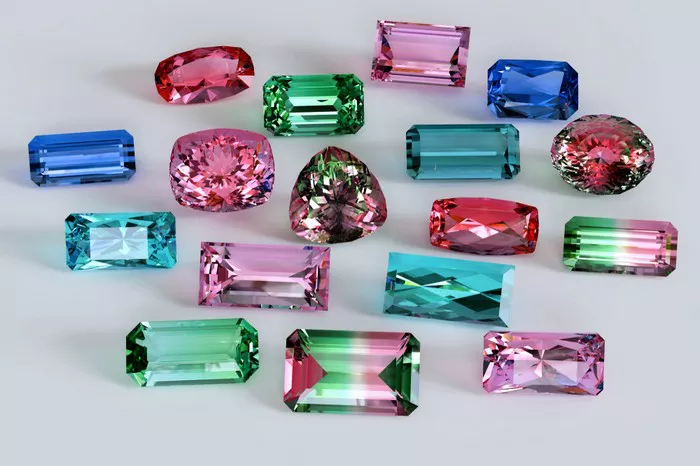Black tourmaline, also known as schorl, is a member of the tourmaline group of minerals. It belongs to the complex boron silicate class and is characterized by its unique crystal structure and appearance. This mineral often exhibits a deep black color and can be found in translucent to opaque varieties. Black tourmaline is highly valued in the gemstone world for its protective properties and ability to absorb electromagnetic radiation. It is believed to cleanse negative energy and bring balance to its wearer.
The crystal structure of black tourmaline is complex, featuring a combination of silicon, aluminum, boron, oxygen, and trace elements such as iron, magnesium, and sodium. This mineral is often found in pegmatites and metamorphic rocks, where it forms as a result of high temperatures and pressures. Black tourmaline’s hardness ranges from 6.5 to 7.5 on the Mohs scale, making it durable enough for use in jewelry and other decorative applications.
Salt: A Versatile Compound
Salt, in chemical terms, refers to a compound formed by the combination of a metal ion or ammonium ion (NH₄+) with an acid radical ion. These compounds are widespread in nature and play crucial roles in various industries and biological processes. Salt can be classified into several categories, including simple salts and complex salts. Simple salts can be further divided into normal salts, acid salts, and basic salts, while complex salts include double salts and complex ions.
The physical properties of salt vary depending on its composition. Most salts are solid at standard conditions, but some exceptions exist, such as molten salts and ionic liquids. Soluble salts conduct electricity in aqueous solutions, making them useful as electrolytes. Salts can also exhibit a range of colors, from transparent to opaque, due to the presence of transition metal ions with unpaired electrons.
In daily life, salt is an essential ingredient in cooking, used to enhance flavor and preserve food. However, its applications extend far beyond the kitchen. Salt is used in the chemical industry for the production of various chemicals, in water treatment to soften water, and in agriculture as a fertilizer component.
Can Black Tourmaline Be Put into Salt?
The question of whether black tourmaline can be put into salt involves understanding the chemical and physical properties of both materials. From a chemical perspective, black tourmaline is a silicate mineral, while salt is primarily composed of sodium chloride or other ionic compounds. These two materials do not react chemically under normal conditions.
Physically, black tourmaline is a hard, durable mineral that can withstand exposure to many substances, including water and some acids. However, placing black tourmaline in salt, especially in concentrated forms or for extended periods, may not be advisable for several reasons.
Firstly, prolonged exposure to salt can cause corrosion or abrasion on the surface of black tourmaline, potentially damaging its polish and appearance. Salt particles can act as abrasives, scratching the mineral’s surface over time. This is particularly true for fine-grained or powdered salt, which can more easily penetrate and wear down the mineral’s surface.
Secondly, salt can be hygroscopic, meaning it readily absorbs moisture from the air. When salt is in contact with black tourmaline, it may draw moisture to the surface of the mineral, increasing the risk of tarnishing or discoloration. This is especially problematic if the salt contains impurities or additives that could react with the mineral’s surface.
Thirdly, from a practical standpoint, there is little reason to combine black tourmaline with salt. Black tourmaline is valued for its protective properties and aesthetic appeal, not for its interaction with salt. There are no known benefits to placing black tourmaline in salt, and doing so could potentially detract from the mineral’s value and beauty.
Uses and Care of Black Tourmaline
Black tourmaline is a popular gemstone used in jewelry and decorative arts. Its deep black color and protective properties make it a favorite among those seeking balance and protection. In jewelry, black tourmaline can be found in rings, pendants, earrings, and bracelets, often set in precious metals like gold or silver.
When caring for black tourmaline jewelry, it is important to avoid exposing it to harsh chemicals, including some cleaning agents. It should also be kept away from abrasive surfaces and stored in a soft cloth or jewelry box to prevent scratching. Regular cleaning with a soft cloth and warm water can help maintain its shine and appearance.
In addition to its use in jewelry, black tourmaline is also used in crystal healing and energy work. Practitioners believe that the mineral can absorb negative energy and promote a sense of calm and balance. It is often placed in various locations around the home or carried as a personal talisman.
Conclusion
In summary, black tourmaline and salt are two distinct materials with unique properties and uses. While it is technically possible to place black tourmaline in salt, doing so is not advisable due to the potential for surface damage, discoloration, and lack of practical benefit. Black tourmaline is best enjoyed in its natural state or incorporated into jewelry and decorative arts, where its protective properties and aesthetic appeal can be fully appreciated.
Related topic:
- How to Clean Green Tourmaline
- How to Choose the Right Amazon Tourmaline Necklace for Yourself?
- What Is Green Tourmaline Stone


